Movie Review By: SFAM
Directed by: Michael Winterbottom
Written by: Frank Cottrell Boyce
IMDB Reference
Degree of Cyberpunk Visuals: Low
Correlation to Cyberpunk Themes: High
Key Cast Members:
William Geld: Tim Robbins
Maria Gonzales: Samantha Morton
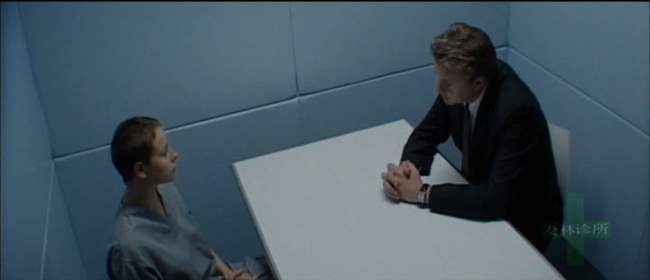
Overview: Code 46 is a movie that generates significant disagreement on ratings. The pacing is glacially slow, but there are enough interesting ideas that many viewers will really dig the final product. Viruses as transhuman upgrades, memory removal, and problems brought on by mass cloning all are mashed together to give an interesting, but somewhat incoherent view of a near-term dystopic future. The cinematography is interesting, and the story itself may end up working well enough for some to enjoy the final product.
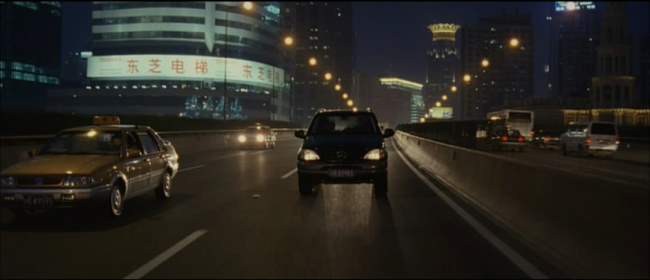
The Setting: Code 46 takes place in a non-specific near future, where overpopulation and degradation of the earth have led to a situation where cities have become protected entities. The population is now divided into those living in the outside and those citizens who have rights to live within. Each city has restricted access – a person is required to have “papelles” (a valid passport/visa) to enter. For some reason, even though there is massive overpopulation, cloning has been used in an overabundant fashion. There is even a law, Code 46, which restricts the relations between those who are genetically similar. Viruses have been genetically engineered to allow new capabilities for people, but also have become so deadly that people must have a valid insurance policy to stay in the city.
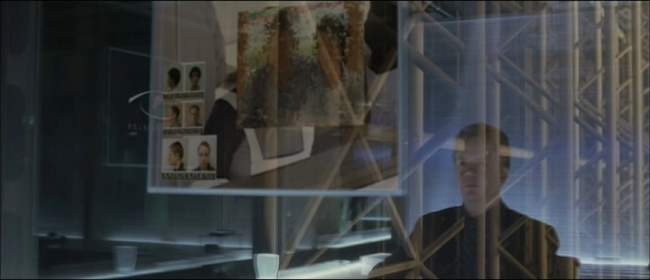
The Story: William Geld, played by Time Robbins, is an insurance investigator imbued with an empathy virus, who’s been tasked to track down a forged papelle ring in Shanghai. Shortly after arriving, William quickly determines that the guilty party is a worker named Maria Gonzales (Samantha Morton), but he doesn’t turn her in. For some reason, even though he is happily married, he is strangely attracted to Maria, so he falsely implicates someone else. After following her home, Maria and William become fall for one another. William leaves the next day for home, but is brought back a few weeks later when the forged papelles continue to be produced. He decides to turn Maria in, but she has left. After investigating, he finds that she had incurred a code 46 violation. William fears that he is the genetically similar party and sets off to find her.
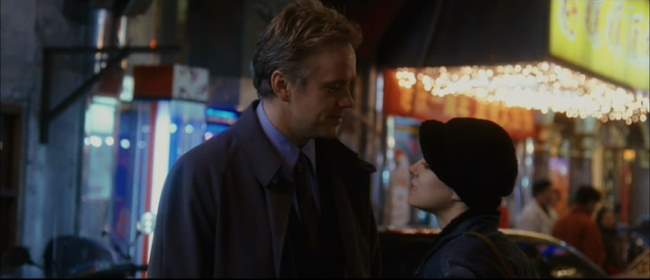
The Acting: Director Michael Winterbottom seems to be going for a Lost in Translation type vibe, but this feel doesn’t really work very well. The leads both turn in believable performances, but something is missing. While the world certainly has an alienated feel, there’s never a sense that the chemistry William and Samantha is strong enough to support a “genetic attraction.” It’s all cerebral. Unfortunately, with the rediculously slow pacing of the movie, this merely adds disconnectedness with the audience.
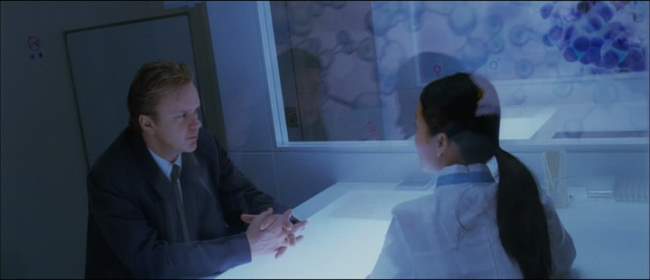
Viruses as Genetic Upgrades: In Code 46, custom made viruses are used for short to long term sensory upgrades. William has an “empathy” virus which allows him to read people’s thoughts. Other viruses allow skills to be developed. The weird thing about the use of viruses as an idea for genetic manipulation is that it causes all sorts of dangerous linkages. For instance, viruses can be passed on, and worse, can change over time. This, I think, is why insurance may play such a large role in Code 46, and why the cities are cordoned off (again, this isn’t really explored all that well). It does make you wonder though, how exactly will genetic manipulation be used in the future? If we are to look for transhuman-like upgrades, are we going to be purchasing an ensemble of cocktail viruses?

Futuristic Low-budget Worldbuilding: Without a large budget, and the absence of CG, director Winterbottom struggles to make his world look futuristic. Mostly based on locations, Winterbottom also emphasizes pastel florescent shades to indicate futurism. Pastel florescent pinks, greens, and blue tones are used in most of the otherwise normal looking city scenes. The outside world is mostly desert, apparently brought on by the effects of global warming, whereas the people all dress like they’re in New Dehli. The night scenes are generally neon shots of Shanghai, which sort of fit in the cyberpunk, near-future genre. Still, there are glaring problems which break suspension of disbelief, where the futuristic world looks identical in most places. The most obvious one deals with the liberal use of modern day cars - apparently the auto industry got laid off after 2003. A cheap solution would have been to jimmy up a few futuristic fiberglass bodies to stick on-top of a jeep or VW, but instead, we are almost left with an alternate view of the present.
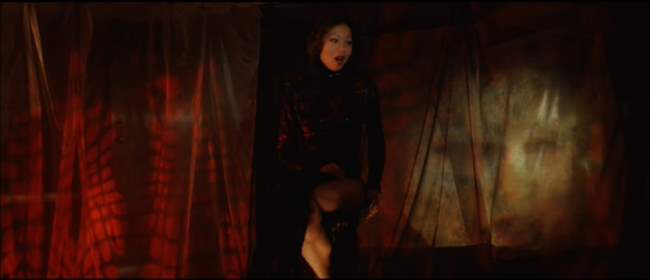
Cyberpunk Tower of Babel – the Creole Merging of Languages: In Code 46, English seems to be the only language used, but it has been “creoled” in that many of the words have been replaced with words from other languages. Boy and girl is now chico and chica; paper is now papelle; hello has been transformed to “meehow”; discontinued is now discontinuago. The cool part about this is how naturally the actors work the word changes into the dialogue. The problematic part of this is that within 50 years or less, the world (even if only the industrial parts) would transform into a single language. If there even is a trend toward this, I think we’d be looking more like 300-500 years for a place like Shanghai to do away with their native Chinese. The more interesting question this raises though is the issue of whether the human race is moving toward a reverse Tower of Babel, or whether the local cultures will become more entrenched as a defense against a globalized language and culture. The world is getting smaller all the time – the implications of this are far from understood right now.
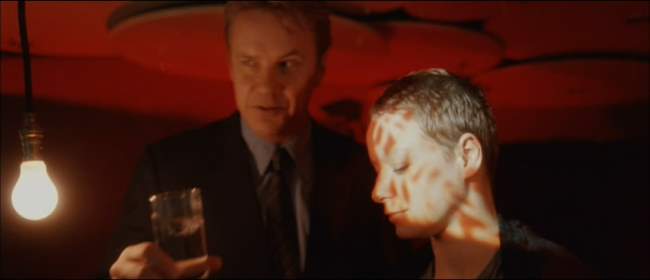
Cyberpunk Oedipus Complex: Harkening back to Freud, Code 46 explores the issue of a man in love with his mother. In Code 46, this connection is so strong that it exists even when the relationship itself is not known to the participants. Personally, I never bought into anything as generalized as Freud’s Oedipus complex, and I don’t know that it works all that well here. But the genetic/cloning slant to this question certainly raises some interesting thoughts. Still, with the advent of overpopulation, its hard to see why people would resort to making an abundance of clones. Perhaps for nefarious thoughts such as body replacement parts, but it would be a stretch for an overpopulated world to create massive versions of the same person. Based on the huge insurance slant in Code 46, we might assume it had something to do with contaminated bodies, but like so many other aspects of this future world, this is never really explained.
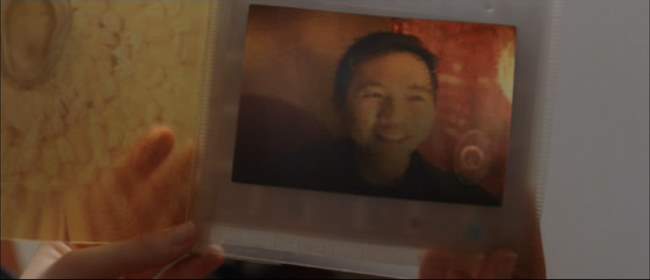
Removal of Memories: The idea of memory modification and their removal has been explored in other movies (Eternal Sunshine of the Spotless Mind, for instance), but the general question is probably similar. Are memories discrete entities that can be targeted and wiped out, or is something more organic going on? Also, if your spouse cheats on you, will a future option for conflict resolution be to simply have the memories of the offending person and the deed itself removed? If so, would you still think your spouse cheated?
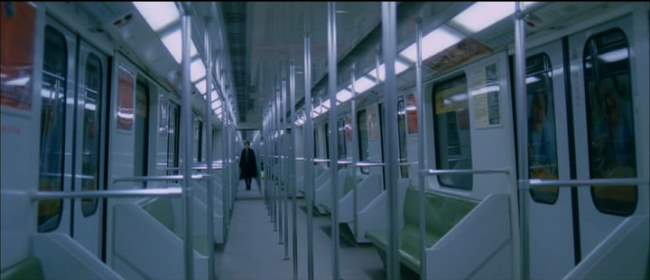
The Bottom Line: Although the plot runs at a glacial pace, and the chemistry between the actors is stilted at best, the inclusion of interesting thoughts, however haphazard, potentially make Code 46 worth a watch. I would have liked to see a bit more clarity on the basis for the technology selections, and definitely would have liked to see more emotive chemistry between the leads. The “Lost in Translation” vibe just doesn’t work here all that well. Bottom line, if you’re someone who doesn’t mind watching interesting looking paint dry, you might end up liking Code 46.
~See movies similar to this one~
Movie Review By: SFAM
Year: 2006
Directed by: Christian Volckman
Written by: Alexandre de La Patellière, Mathieu Delaporte, et al.
IMDB Reference
Degree of Cyberpunk Visuals: Very High
Correlation to Cyberpunk Themes: Medium
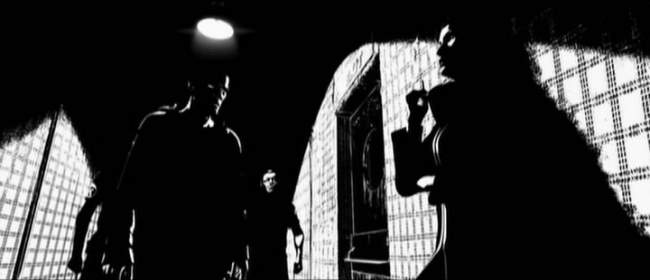
Overview – Good luck in finding a copy! Once upon a time, Renaissance was one of my most anticipated movies of 2006. Originally released in France on March 15th, I eagerly awaited its September release in the US. My anticipation was heightened in that I was even contacted by Miramax representatives as part of a pre-hype blitz. So imagine my surprise when its release in the US only comprised a few select cities – unfortunately my city didn’t make the cut (thanks Miramax!). Similar to so many other good, but foreign science fiction and fantasy flicks, instead of getting a nice theatrical viewing, I was yet again forced wait and then later buy an import (or pirated – sometimes you just aren’t sure) DVD off of eBay. If you are in the US and are interested in seeing Renaissance, chances are you’re in the same boat. One would have hoped that a movie as visually stunning as Renaissance would have been at least able to quality for a DVD release, but clearly something larger is going on here as many other foreign genre films are in the same boat.

The Setting: In the year 2054, mega-corporations are all-powerful, with tentacles in all aspects of life. The divisions between rich (megacorps) and poor are greater than ever. Paris has grown in layers, with high-tech buildings pushing every further into the sky. Although the city is sleek and stylish, most people live a pathetic existence. In Paris, the Avalon Corporation rules the cityscapes. The police force is not immune from their pressures, and often become their lackeys.
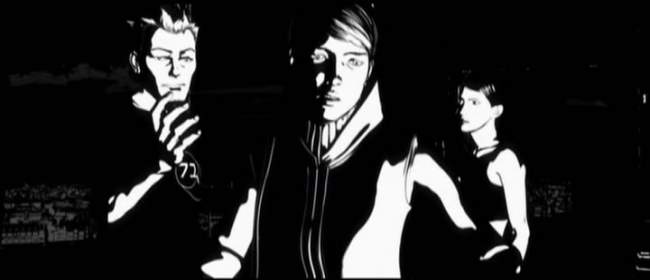
The Story: When a promising young biogeneticist named Ilona (voiced by Romala Garai) from the Avalon Corporation is kidnapped, detective Barthélémy Karas (Daniel Craig) and his team are brought in to investigate. As Karas interviews all the key players, it becomes clear that this isn’t a simple missing person case, as the details of the disappearance become increasingly more bizarre and complicated. The Avalon corporation president, Dellenback (Jonathan Pryce), not known for his loyalty to his workers, is extremely interested in her return. Ilona’s bioengineering mentor has a strange past, and stopped doing research after an accident from 2006. Karas befriends Ilona’s older sister, Bislane (Catherine McCormack), who tells of a stolen book.
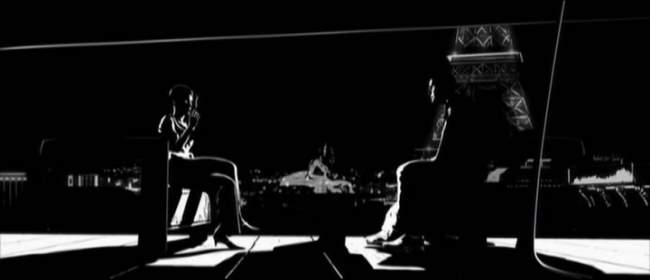
Similar to Howard Hawks’ “The Big Sleep” (1946), Karas spirals back and forth between the key players as more clues are provided. Karas uncovers a darker side of the Avalon Corporation, and of Ilona’s mentor, Dellenback. Furthermore, it appears that the secret to immortality has been discovered, and is tied to Ilona herself. As Karas and Bislane continue searching for Ilona, the list of enemies grows. The key players are getting offed, Karas is booted from the force, and is now in fear of his life. Worse, they are discovering that humanity itself may be at risk if Ilona is found.
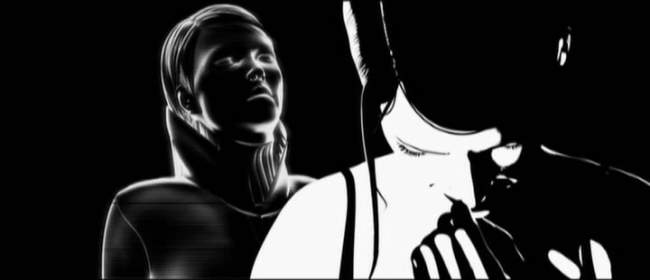
The Characters: It’s not a stretch to say that virtually every character in Renaissance comes “cookie cutter” from the old noir movies, with a nice slice of traditional cyberpunk thrown in the mix. From the honest but jaded crusty cop with a soft spot to the megalomaniac mega-corporation leader, to the shady friend the cop goes to when he needs a favor to the femme fatale; don’t expect freshness, because it isn’t coming. Like the old noirs, everyone in Renaissance is flawed; everyone is gray – which does make for an interesting contrast when transposed on such stark black and white animation.
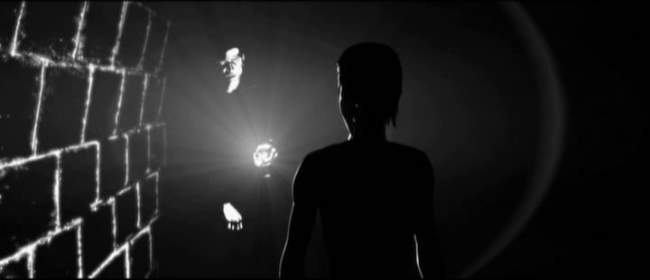
The Atmosphere: While the story falls short, the look of Renaissance fully original and is flat-out amazing. If Renaissance is best described as style over substance, the style really comes STRONG to the party. Stark black and whites dominate virtually every shot. Shadows are in abundance, and usually highlight the main action points. Gray is used sparingly, and is usually applied to change the mood of the scene. To its credit, Volckman succeeds at creating a near-future world that is deeply flawed but not overly futuristic. The cityscapes are incredibly detailed, and give the impression that there are always a bevy of interesting happenings occurring. A transparent glass-like substance is now used to make walkways above and below the roads – this more than anything creates a sleek, near-future ambience. The stark black and white look of Renaissance works well both in the daylight and evening shots, both having shadows prominently placed in virtually every frame.
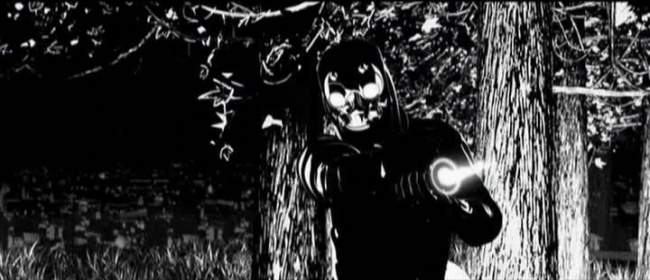
Traditional cyberpunk conventions are often applied, including huge billboards of beautiful women that extol the virtues of the Avalon Corporation. Avalon fills the role of the dominating mega-corporation that owns and controls virtually everything in Paris. Nothing is beyond their grasp. The police are on their payroll, and the entire city appears to be under surveillance. Immortality, derived through advances in bioengineering (initially undertaken by a Japanese scientist) is the dominating technology intended to challenge God’s position over humanity.
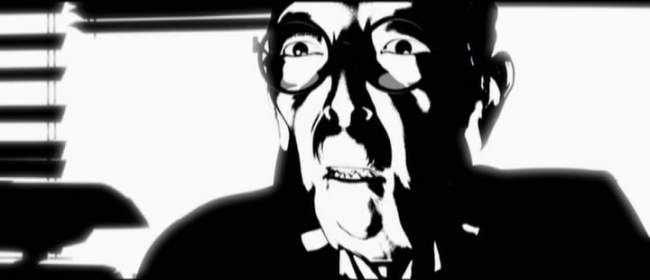
Similarities with Sin City: Volckman stated he was interested in creating a visual feel similar to what one might get when looking at a painting. In terms of what was produced, yes, the look is definitely similar, but Renaissance is not copying Sin City. Although Sin City came out first, Renaissance started its production far before Sin City. In terms of look, Renaissance really does match very closely with the Sin City graphic novels – more so than Sin City in fact. But while it also is a neo-noir, the dialogue and mood of Renaissance is far more like a corporate espionage version of a standard 40s detective noir (think “The Big Sleep” with corporations instead of the mob), whereas Sin City had more of a hyper-real, over-the-top neo-noir feel.
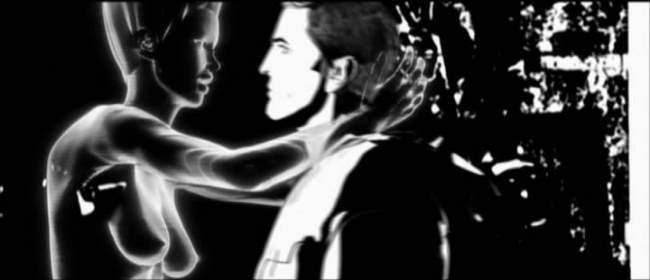
The Animation: Using an innovative motion-capture to rotoscope approach, where 24 cameras are used when shooting the actors, Volckman was able to work on the framing and viewpoint well after the shoot was complete, and then paint on the black and white animation. Unlike Linklater’s rotoscoping, where the actors’ faces and body appear to be constantly shifting, the level of precision used in Renaissance is significantly higher. When moving, the sprite’s actions are incredibly human-looking. There is a slight lag though when they first take action – a noticeable lag that’s slower than you would expect a person’s actions to be.
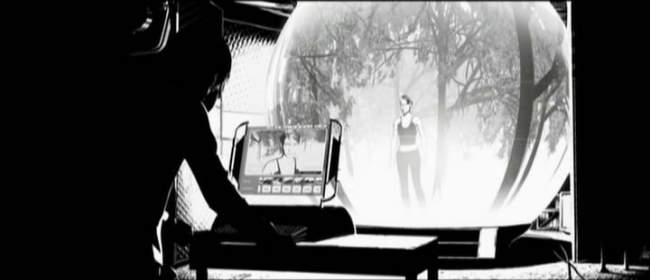
The Technology: While the basic story for Renaissance is straight cyberpunk neo-noir, the technology options provided are numerous and fairly interesting. Most visually arresting was the Holodeck sphere prison where Ilona is kept. Karas had a very advanced cybernetic eye implant that allowed him to identify people through solid objects – it also was able to be hacked by Avalon, the Mega-corporation. Computers are slick, now often just the size of a pen with a virtual display that arises upon command. Biotechnological modifications are in vogue, although not at the level of Ghost in the Shell. Similar to Motoko’s invisibility suit, the goons at Avalon have similar suits, although they look more like the soldiers in Jin-Roh than they do the hawt, naked Motoko. Holograms are now used in combination with pictures to remember people and events – in some cases, holograms interact with their human counterparts.
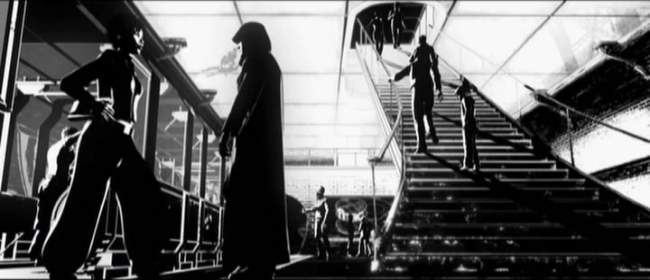
Do you Want to Live Forever? One thesis of Renaissance is the notion that immortality, if invented, would destroy humanity. Not a lot of backing is provided for this idea, but the idea put forward is that this irrevocable change in the hands of a mega-corporation would provide a method of control so powerful that society would no longer function. This is all the more interesting in that some are predicting that humanity will have the equivalent of immortality within the next 50 years. If this comes to pass, will the possibility of immortality be distributed evenly or will this be a tool of domination similar to in Renaissance?
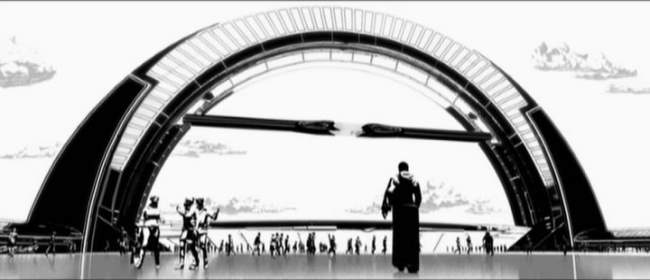
The Bottom Line: Although the story and characters are not original, the animation and overall cinematography is both innovative and outstanding, and should not be missed. There is truly something unique in the look here that you just won’t find anywhere else. The voice and motion acting are more than passable and Nicholas Dodd’s score provides a wonderful combination of a 007 espionage flick with the haunting eeriness of the score from Stargate. As icing on the cake, the science, technology and architecture exhibited in Renaissance will make you think. It may be hard to find, but it’s well worth the time spent looking for it.
Page 2, More Screencaps–>
~See movies similar to this one~
Movie Review By: SFAM
Year: 2004
Directed by: Shinji Aramaki
Written by: Masamune Shirow (Manga), Haruka Handa & Tsutomu Kamishiro (screenplay)
IMDB Reference
Degree of Cyberpunk Visuals: Very High
Correlation to Cyberpunk Themes: Medium
Key Cast Members:
Deunan Knute: Ai Kobayashi
Briareos: Jûrôta Kosugi
Hitomi: Yuki Matsuoka
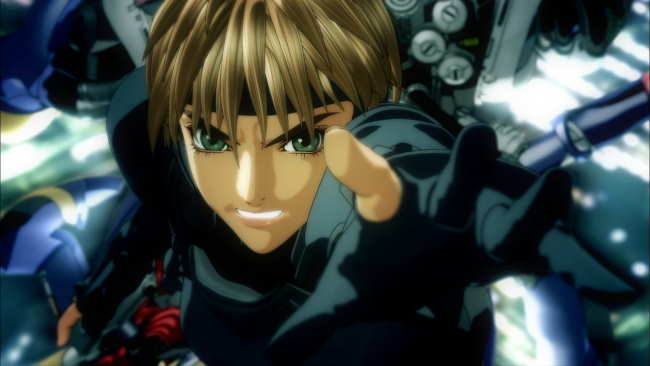
Overview: Masamune Shirow’s Appleseed recently got a second anime treatment. The last was in 1988 – this time, in 2004, the anime is done up in eye-popping 3D graphics. With a budget of only 10 million as compared to over 90 million for a movie like The Incredibles, we shouldn’t be expecting too much. Surprisingly, we get far more than expected, especially with regards to the wonderfuly rendered backgrounds. While the animation is interesting enough, the story is more problematic. So too are the change in the feel of the characters. This is really where the original version succeeds far better than Aramaki’s version.
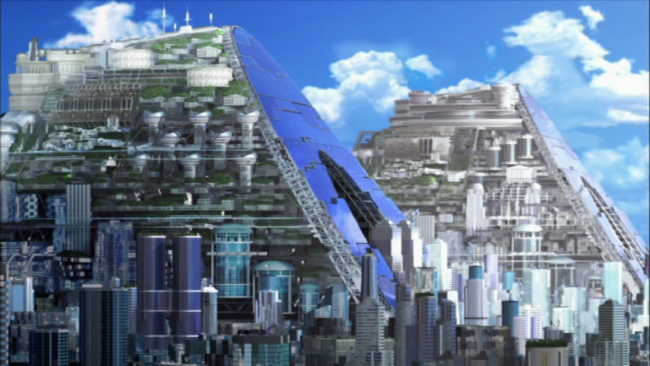
The Story: Appleseed takes place in the year 2131, a war-ravaged dystopian future where most all of human society is in ruins. Over two years after the last war, the only example of advanced human civilization is a newly made city called Olympia, which has been engineered to be a created as a perfect refuge from the rest of the world. Over half of the city’s inhabitants are comprised of bio-engineered “biodroids,” which are human-like beings designed to serve specific roles in the society. An all-knowing computer named GIA supports the city council in controlling all aspects of city life.
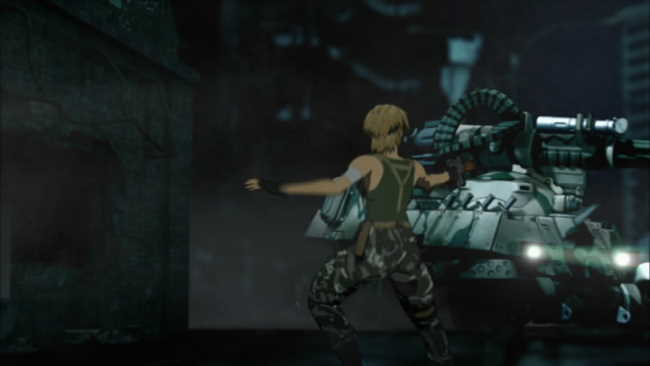
Deunan Knute, a fighter extraordinaire has been living alone in the wastelands, not realizing that the war is over. She is beset by two warring groups of fighters, one of which who is trying to kill her, and the other group, which rescues her and takes her to Olympia. There she is re-acquainted with her long lost lover, Briareos, who now has been transformed into a cyborg after his body was lost in the war. She is tasked to join “ESWAT,” a special mecha-enabled police force that keeps order within the city. Deunan also befriends a biodroid named Hitomi, who shows her around the city. Unfortunately, Deunan barely gets a chance to settle down before the assassination attempts on her life start.
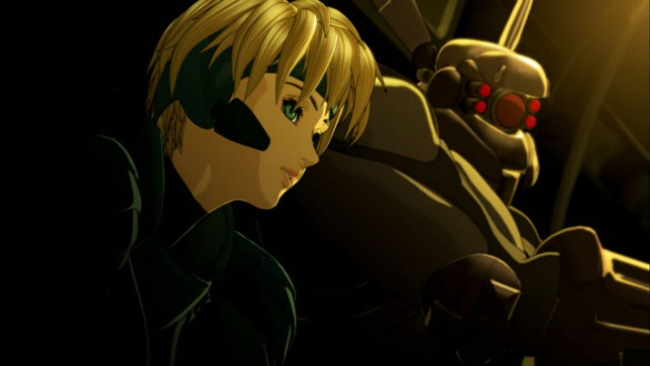
Duenan quickly learns that she has been dropped in the middle of a power struggle between humans, who are concerned that the biodroids secretly aim to exterminate them, and biodroids, who worry the same about the humans. Somehow, Deunan has become essential in this struggle, yet it has nothing to do with her fighting capabilities. It turns out that her parents, before dying, developed a method for biodroids to reproduce, which would make them almost exactly like humans. But this research was lost long ago. Now, Deunan has become a pawn for both sides of this struggle, and worse, it appears as if her ex-lover, Briareos has chosen sides.

Unfortunately, the story in this version of Appleseed is problematic at best. There are too many sub-plots that obfuscate the key points. The myriad of loose ends introduced that are never followed up on. Gia, the sentient computer that runs Olympus is the probably the worst casualty. We get introduced to her, and, if you know something of the Appleseed story from the Manga, you expect to see lots more than what actually ends up being conveyed. In the end, the plot centers on a simple theme of racism. This is a shame as there were so many interesting cyberpunk aspects of Olympus that get short-circuited.
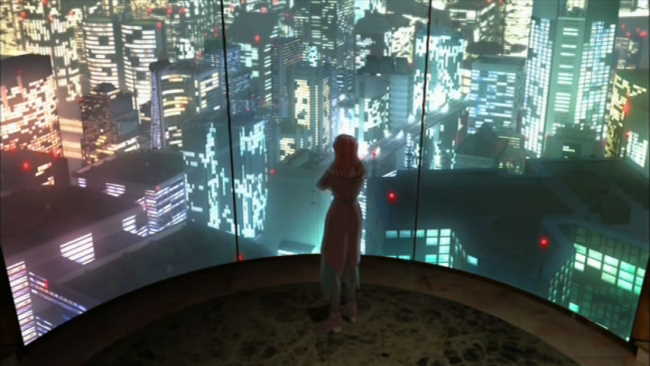
The Animation: Appleseed’s backgrounds are wonderfully rendered. This more than anything accounts for the majority of the “wows” Appleseed received. They are done in a way that allows 3D camera maneuvering, so as to allow you to see the same scene from multiple angles, and at times, even provides Matrix bullet-time effects. For the most part, the 3D CG overlaid with 2D cell shading really works. It’s an extension of the idea we saw in Malice@Doll, only with far better rendering tools. The machines look especially awesome. Both the Gunhed style tanks at the beginning of the movie and the platform sentinels at the end. Unlike many cyberpunk movies, there isn’t a dominating color palette in Appleseed, but the color scheme seems to stick more often than not to light and dark shades blue-greens, with yellow & browns in transition scenes.
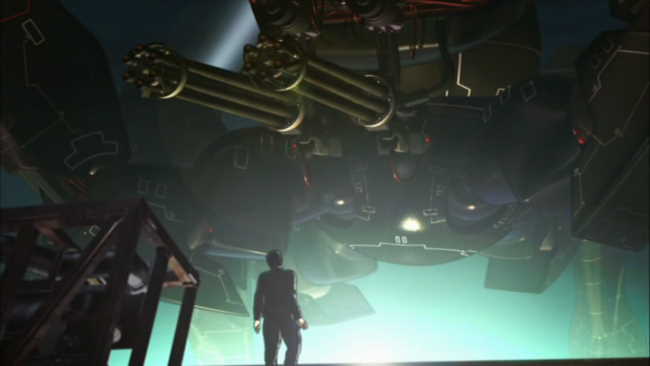
In terms of the characters, only Deunan Knute really looks polished. Her body movements, facial expressions and general actions really work. The rest, especially the human characters, often look stilted in their moments. Hitomi, their biodroid friend, is especially problematic at times. This might be due more to the motion-capture techniques they use, which work wonderfully for the city, but not so well for the characters. Also, I really dislike the way they animated the hair. The hair on the humans in the 2004 edition look like something out of Reboot. However, considering the budget, I think they made the right decision in spending scarce resources on Deunan. Had they just made everyone look slightly better, Appleseed would have faltered horribly. By at least making Deunan polished, they developed a star that fit right alongside their wonderful backgrounds.
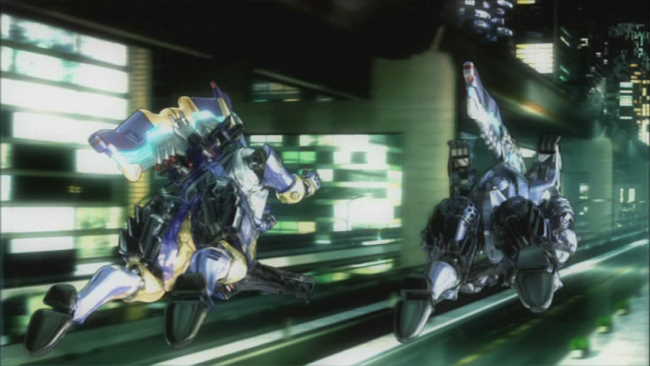
The Sound: Many times throughout the anime, Appleseed plays more like a music video than it does a movie. The modern heavy rock beats worked well for the action scenes. And truly, the action scenes are where Appleseed excels. There, the 3D positional sound, the music accompaniment and the 3D CG graphics are at their absolute best. The accompanying score really wasn’t all the memorable, but at least served up the slower paced moods fairly well.
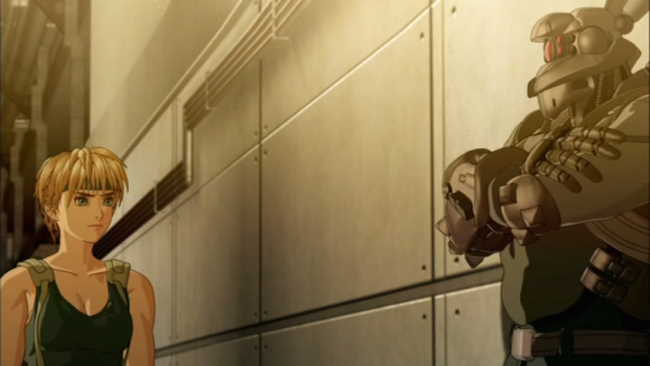
Differences From Shirow’s Work: While both animes deviate from Masamune Shirow’s Appleseed Manga, Aramaki’s version is the most egregious. While the 2004 version starts outside of Olympia as the Manga does, it only has Duenan there, whereas in the Manga has both. This version introduces a new dramatic twist of Duenan and Briareos getting back together for the first time in two years. While this in itself isn’t bad, the side-effect is: these two characters are no NOTHING like the Manga. The Duenan Knute and Briareos of Shirow’s Manga, and of the 1988 version, are precursors to the Ghost in the Shell’s Motoko and Batou. Here, Briareos is a moody, lost soul trying to deal with his cyborg body, and Duenan is far more vulnerable than tough. The playful chemistry we see between these two both in the Manga and the 1988 anime is completely missing here. For those who aren’t familiar with the Manga, this probably won’t bug you, but it certainly sapped some of the enjoyment out of this movie for me – so much so that I’m dropping a star off the review for it.
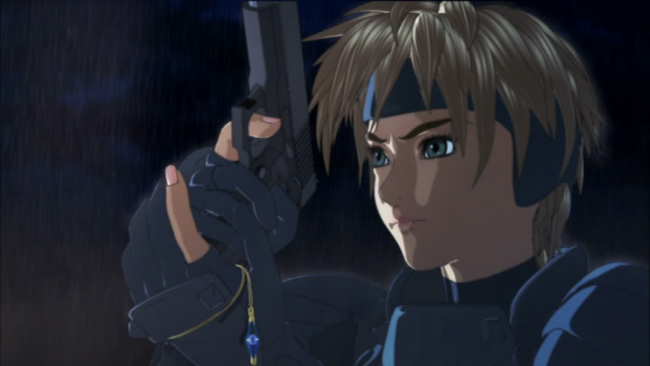
The Bottom Line: Appleseed is definitely worth seeing for the visuals alone. While some of the characters don’t work, the Duenan, the machines and the action scenes work wonderfully. Unfortunately, the story doesn’t equal up. Too many elements are introduced and then discarded in favor of a truly simplistic storyline. They could have done better. Also, as I mention above, this is not the Deunan and Briareos I’ve become familiar with – these characters are different from both the Manga and the earlier anime. This bugged me enough to drop a star from the review, but you might not mind so much.
Page 2: More Screencaps –>>
~See movies similar to this one~
Year: 1993
Directed by: Hiroshi Fukutomi
Written by: Yukito Kishiro (Manga), Akinori Endo
IMDB Reference
Degree of Cyberpunk Visuals: High
Correlation to Cyberpunk Themes: Very High
Key Cast Members:
Gally (Alita): Miki Itô
Ido: Kariya Shunsuke
Yugo: Kappei Yamaguchi
Chiren: Mami Koyama
Vector: Shigeru Chiba
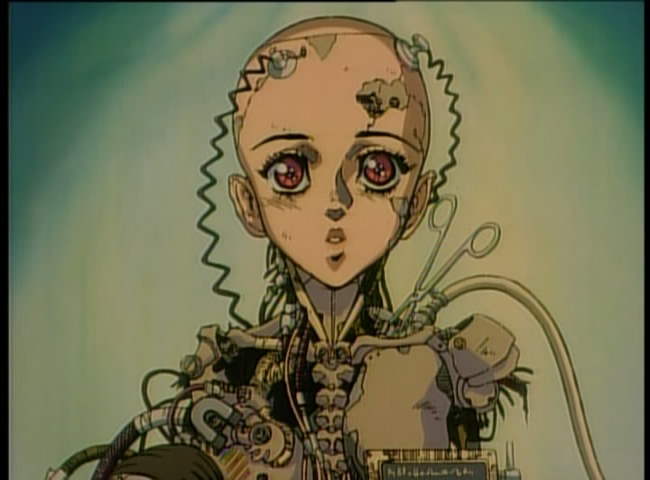
Overview: Battle Angel is based off a very well done Manga series called Battle Angel Alita. The movie covers the first two volumes of the Manga: Rusty Angel, which documents Alita’s “rebirth” and Tears of an Angel, which portrays a tragic love story. This anime from 1993 is one of the best man-machine interface animes out. The story is solid, and the drawing for that time period is terrific. While you might hear some gripe that the Manga is better, I think Fukutomi did a terrific job in taking Kishiro’s story to anime. I can only hope that James Cameron does a similarly wonderful job with the upcoming live action version of this. Just a warning - this is not a kids story - it contains lots of blood, head removals and minor amounts of nudity.
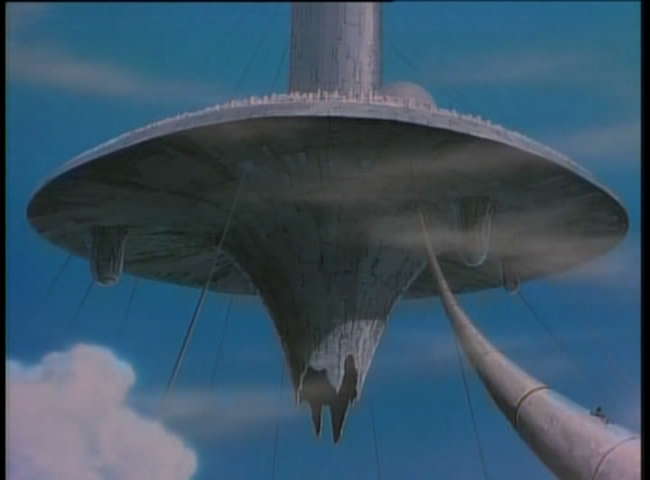
The Setting: Battle Angel takes place far into the future, after a societal collapse has occurred. Advanced human society has been relegated to a floating city called Zalem, that sits above a refuse heap called Scrap Iron City, which is inhabited by denizens living off the scraps and waste products Zalem expels. A corporation called the “Factory,” the primary employer for Scrap Iron City, sends products back up to Zalem through a series of huge metal tubes. Cyborg technology has become a way of life, with many “humans” having only their brain remaining from their original human body host. Scavenging and theft has become a way of life for many. Backbones are a particularly sought after commodity by thieves, who sometimes will violently take them from their living hosts. As social services no longer exist, the Factory posts “bounties” for the heads of the most egregious villians, which bounty hunters, called Hunter-Warriors pursue for money.
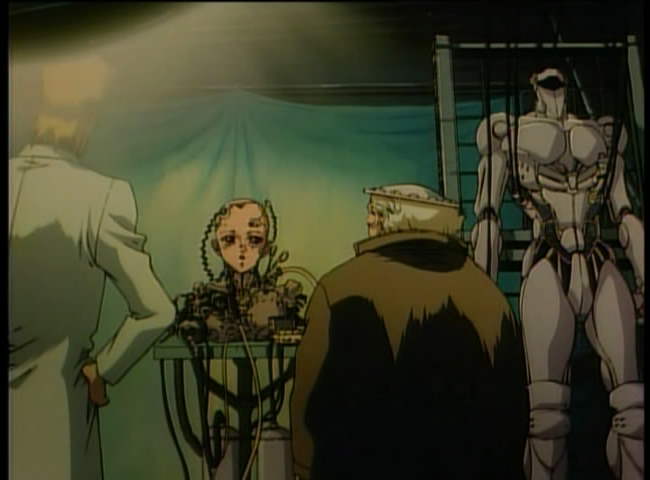
Rusty Angel: Daisuke Ido, an cyborg doctor extraordinaire, former citizen of Zalem, scavenges through the refuse heap to find spare cyborg parts to repair the citizens of Scrap Iron City. One day he comes across a female cyborg head that has a still-living human brain in it. He sets out to repair this head and gives her a wonderful body off of parts he has collected. He names her Gally (she is called Alita in the Manga), and she seems totally restored, except for the loss of memory from her earlier life. Ido becomes attached to Gally and they quickly develop a father-daughter type relationship.

Gally learns that Ido moonlights also a Hunter-Warrior both for moral reasons and to support his medical practice. Gally saves Ido from certain death, and thus, reveals that she, in her former life, was also a very talented warrior. Under protest from Ido, Gally asserts her individuality and desire to become a Hunter-Warrior like Ido, so that she too can have purpose to her life.
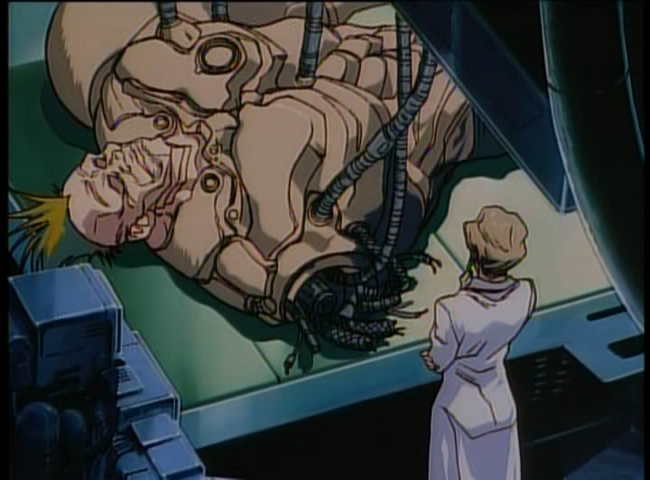
Chiren, also a cyborg doctor and Ido’s former partner, has also been ousted from Zalem, and is consumed with finding a way to return. Deciding that she will do anything to make this happen, Chiren hooks up with Vector, a shady character who has connections with the “Factory,” who agrees to eventually take her to Zalem in return for sexual favors and for her assistance in building a supra-cyborg gladiator named Greweicia for the fighting ring. This cyborg warrior also has a penchant for eating brains, and ends up on the bounty list. Chiren, wanting to be seen as superior to Ido, gets Greweicia to fight Gally in the hopes of destroying her, and thus, destroying Ido.
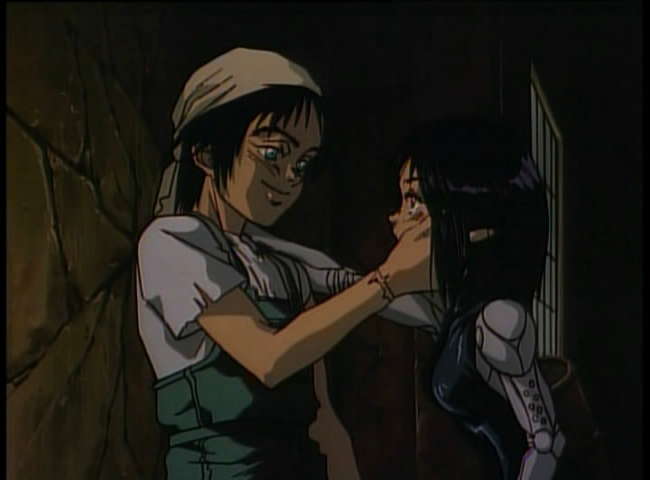
Tears of an Angel: Gally, in exploring the city has become infatuated with a hard working body named Yugo, who dreams of going to Zalem. Although it’s common knowledge that nobody born in Scrap Iron City can ever go to Zalem, Yogo is also consumed with finding a way, and has gotten an agreement from Vector, who promises Yugo if he can make 10,000,000 credits, than he will take Yugo to Zalem. Yugo has taken him up on his offer and has started stealing cyborg spinal cords as a way to augment his day job of fixing machinery. He is discovered, and is put on the Bounty list. Gally, who has fallen deeply in love with him, tries to rescue him from a rival bounty hunter. Unfortunately she is too late, but is able to save his head, and asks Ido to turn him into a cyborg. Even after becoming a cyborg, Yugo’s dreams of reaching Zalem cannot be abated, as he sees his life a struggle against the worthlessness that is the Scap Iron City.
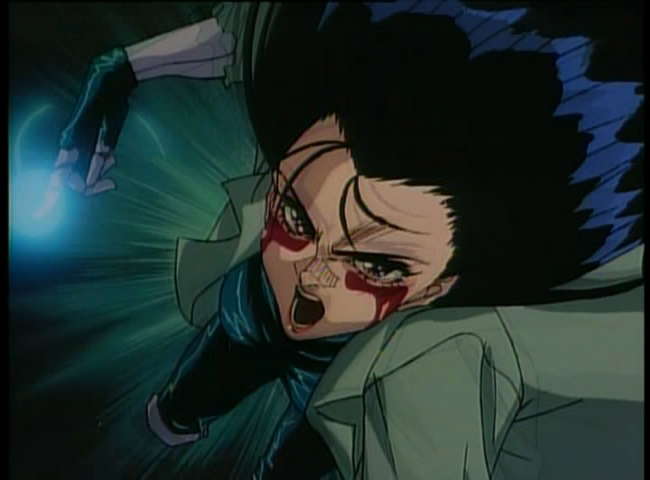
The Artwork: In Battle Angel, we see strong influences of Akira in most every aspect of the production. From the facial expressions to the darkly textured backgrounds to the fighting style approach, Battle Angel clearly has used Akira as a template for modern animation techniques. Like many OAVs of this time period, some of the backgrounds are bland while others are lavishly penned and inked with multi-layered designs. They “pick their battles” with the designs, but for the most part, the decisions are solid. The simple designs are in backgrounds such as the sky and in Ido’s house. The more complex ones are in the underground, Yugo’s hang out, and in the refuse heap scenes – this is where most of the action and plot take place.
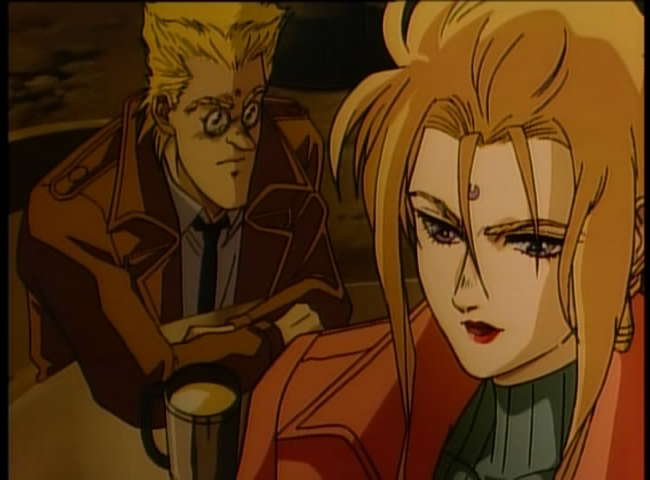
Changes from the Manga: While I think Battle Angel is a terrific anime, there are some changes from the Manga that some find annoying. Most bizarre is the renaming of Alita to Gally, and the city Tiphares to Zalem. However, unlike some, I don’t find the changes in the plot to be that problematic. The anime wonderfully captures the essence of the Manga. Perhaps the biggest change is the rationale for Alita’s powers. In the anime, we really don’t get an explanation, but in the Manga, Alita is first given a normal body by Ido, and ends up destroying it in her first fight. Realizing that Alita is a warrior at heart, Ido gives her the body he has saved for a long time – that of a berserker warrior. The primary villain in Rusty Angel is also different – he is a being who has grown up in the sewers, and after losing his body in fighting Alita, he takes over the Gladiator’s body. And Chiren, a central character in the anime is not in the first to novels of the Manga. Again, for the most part, I have no problems with the changes, and actually love the dimension that Chiren adds.
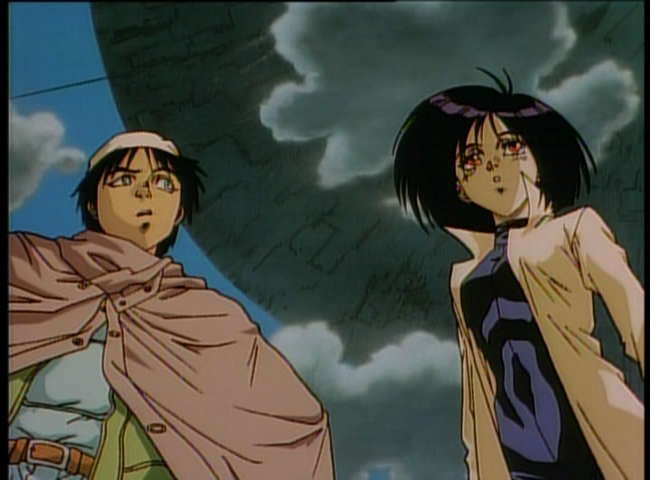
The Bottom Line: Battle Angel (Alita) just works for me as an anime. It is intelligent enough and well enough executed to get you to imagine a world where cyborgs are a reality. The world from the underground perspective is well done and Alita (I call her Alita, not Gally) as a character is terrific. Along with Armitage III and Ghost in the Shell (obviously), Alita is one of the best animes of this kind. Just a caution for those who have only seen the VHS, like most Japanese animes, Battle Angel comes off FAR FAR better with the Japanese dubbing cast than it does the English cast.
~See movies similar to this one~
Year: 2001
Directed by: Rintaro
Written by: Osamu Tezuka, Katsuhiro Ôtomo
IMDB Reference
Degree of Cyberpunk Visuals: High
Correlation to Cyberpunk Themes: High
Key Cast Members:
Tima (voice): Yuka Imoto
Kenichi (voice): Kei Kobayashi

Overview: Metropolis is a wonderful anime that, while it shares the same name as a far more famous movie, it is in fact a different story altogether. In this story, also set in an astoundingly beautiful futuristic city, with three tiers of inhabitants - the elite, the human working class, and all the way at the bottom, the slave-like robots. The powerful corporate leader who runs Metropolis, Duke Red, has created a structure called the Ziggurat, a huge tower designed to control all information and machines in the world. To make this possible, he hires Dr. Laughton, a genius criminal scientist to make a an super-android focal point of the Ziggurat, who is designed in the image of his daughter.
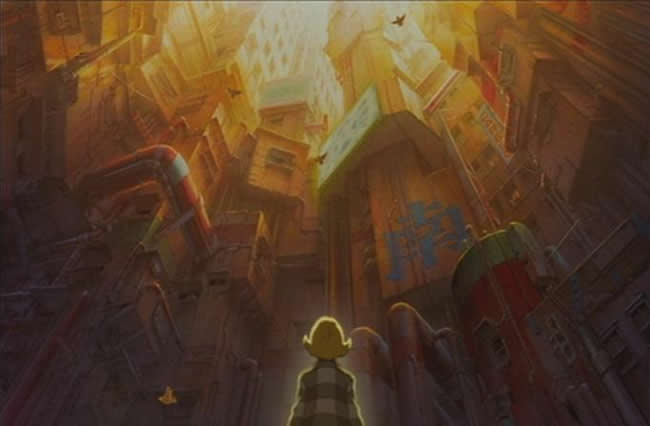
Fortunately for the world, their plans are disrupted when Shinsaku Ban, a detective from Japan, and his nephew Kenichi, arrive to track down and capture Dr. Laughton. They disrupt the “birthing” of the super-android, called Tima, and destroy the lab. In the ensuing chaos, Kenichi finds Tima, and thinking her human, rescues her from the destruction. They become separated from Separated from his uncle, and begin a journey of discovery in the lower levels of Metropolis.
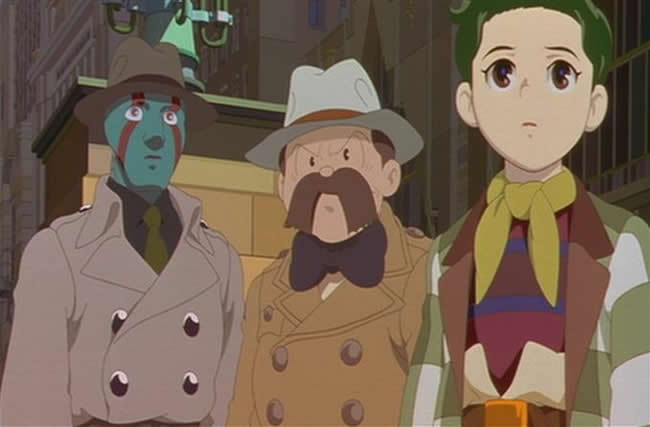
Eventually, Duke Red learns that his super-android is alive and well, and dedicates everything to catch her. Over the course of the movie, Tima begins to learn her true nefarious purpose, while at the same time, begins to fall in love with Kinichi. This becomes a story of questioning what is humanity, and whether robots can be loved and treated like humans, or whether they are machines to be used for our purposes.
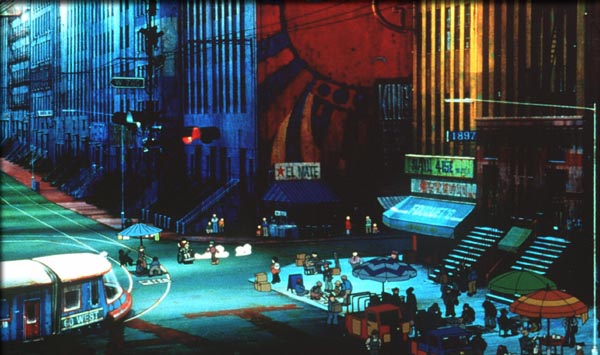
The Visuals and Sound: The visuals in metropolis are both varied and often astounding. We get a wonderful mix of 2D-3D graphics - unlike most movies, they are definitely weighted towards the 2D side. And I love how Metropolis makes the change in colors from almost a pastel-type opening to dark and dirty colors as the movie progresses. This is very similar to how Transmetropolitan does it in graphic novels. The characters are done in an interesting style, with almost completely round heads. This is disconcerting at first, but eventually you get used to it. And top top if off, we get some of the most wonderful use fo music in an anime. Some of the old fashioned Jazz tunes in here create a wonderful retro-type mood that really seems to fit.
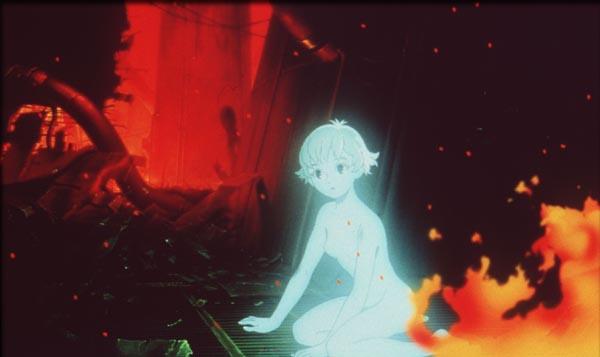
The Bottom Line: Metropolis is a terrific little anime, although I would have liked to have seen a few parts of the script flushed out a bit more. Still, I love the movie, but it’s the ending that makes it for me. Tima’s question at the end pretty much sums up the purpose of the movie. This is a really nice exploration into the nature of humanity thing from a cyberpunk film standpoint.
~See movies similar to this one~
Tags: cyberpunk movie review anime metropolis
Year: 1988
Directed by: Kazuyoshi Katayama
Written by: Kazuyoshi Katayama, Masamune Shirow (manga)
IMDB Reference
Degree of Cyberpunk Visuals: Medium
Correlation to Cyberpunk Themes: High
Key Cast Members:
- Deunan: Masako Katsuki
- Briareos: Yoshisada Sakaguchi
Rating: 7 out of 10
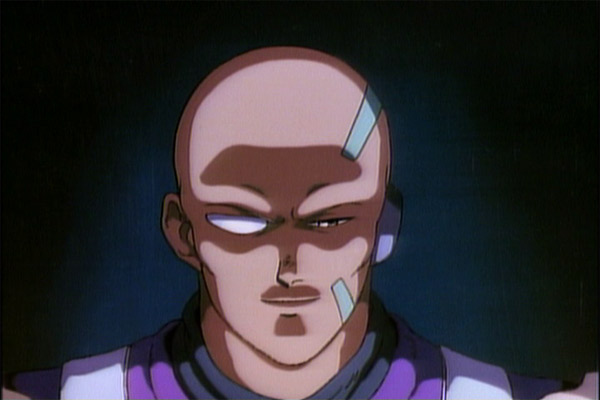
Overview: Released the same year as Akira, this Masamune Shirow story is far more an artifact of 80s Anime, whereas Akira points the way to how anime will look in the 90s. This early Mecha movie is violent, profanity laden and action packed, with a really nice story and interesting philosophical undertones. And interestingly, this is one of the very few animes where the English track is actually the best one.
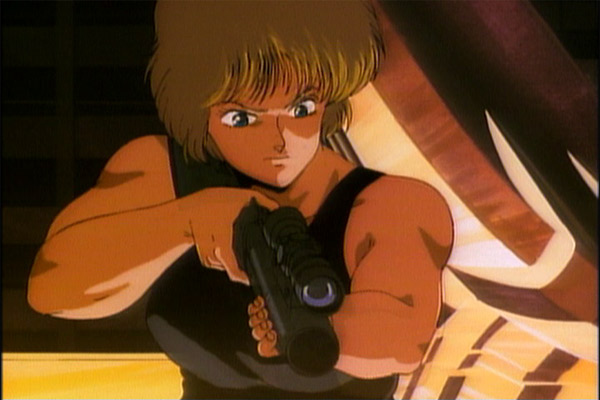
The Story: Appleseed takes place in a dystopian future, in which a city called Olympus has been engineered to be a created as a perfect refuge from the rest of the world. Many of the inhabitants have been bio-engineered “biodroids,” which are half-human, half-cyborgs designed to serve specific roles in the society. An all-powerful computer named GIA controls all city functions, and is just now starting to become responsible for the defense systems. Olympus is so controlled that there is little diversity or struggles required from its inhabitants.
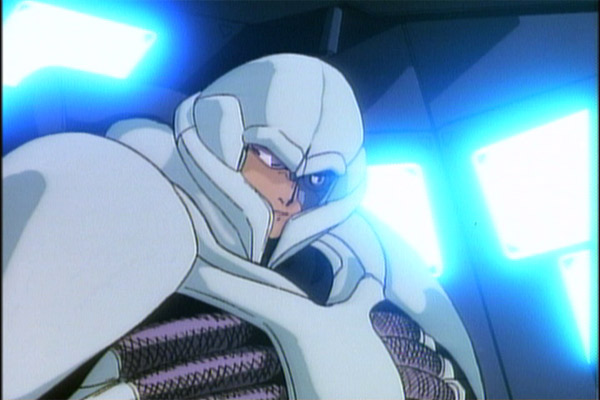
A cyborg terrorist named Sabastian has made it his mission to destroy GIA. He finds a kindred soul in a disenchanted police officer, who’s wife committed suicide after she couldn’t stand living such a controlled existence. They plot to take over the prototype impenetrable tank in order to kill Gia and destroy Olympus. The movie centers around the mecha-laden Swat police force aligning their forces to stop them. In addition to heavy violence, we get MASSIVE amounts of F-bombs dropped here. Its actually rather cool seeing the amount of profanity that is used here - far more than one would expect from an anime such as this.
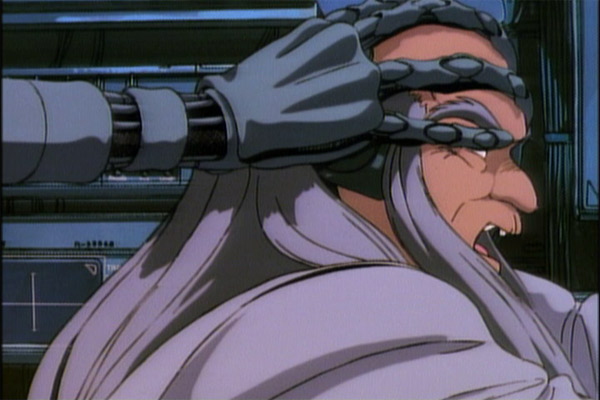
Deunan, a hot police chick and Briareos, a bug-like looking cyborg are Swat team members assigned to stop the terrorists. Incidentally, these two are clearly the precursors for Major Motoko Kusanagi and her cyborg partner, Bateau. While Deunan keeps her clothes on and doesn’t have Motoko’s intelligence, she definitely fills the same roll. Spunkiness is her middle name. The rest of the group, including Sebastian the terrorist, and the rest of the police force all provide decent support.
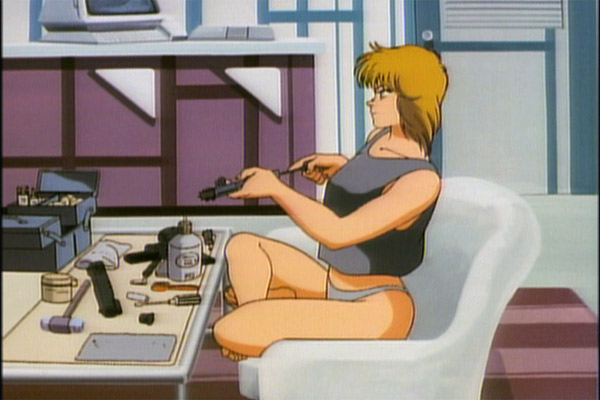
The animation here is still mostly 80s american style. Additionally, unlike the anime of the 90s, the backgrounds are often single, simple colors. While some animation scenes are rather cool, others are really more simple than you’d want. Definitely, the majority of the animation effort is about highlighing Dunan - she definitely looks better than everything else around her. Also, the sound is 80s keyboard music. Sometimes it works, but mostly its just distracting.
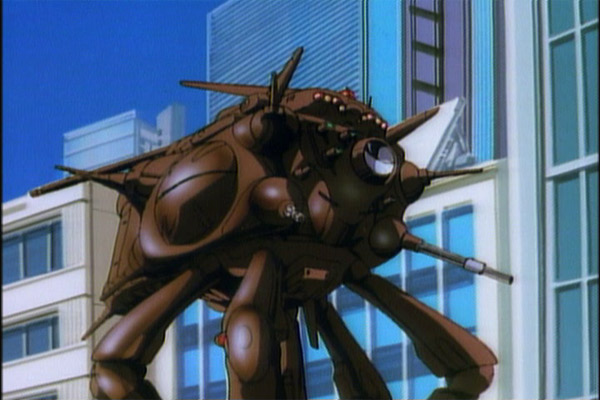
There are a number of messages that Appleseed puts forth. Looking at it today, the most disturbing message deals with Olympus’ rather extreme attempts to protect and inculcate itself from outside terrorists. The symbol for this is a bird in a cage. Considering that the US is in the throws of working this exact issue, Appleseed gives us a stark reminder that we can easily lose the soul of our society while attempting to protect it. Additionally, there are somewhat brief inquiries into what “life” is when examining whether biodroids should be valued similar to humans.
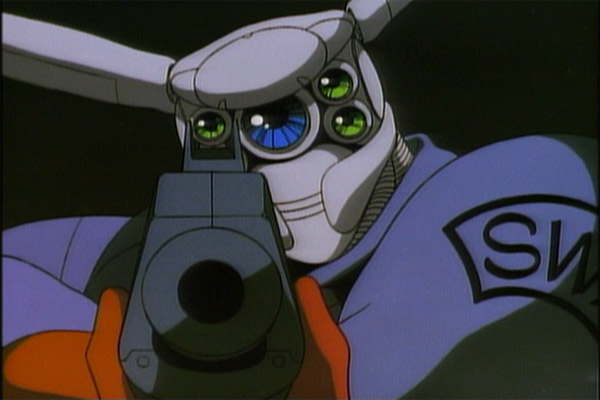
The Bottom Line: Appleseed is a good example of very early Japanese Anime. While its nowhere near the top in terms of animation, the Masamune Shirow’s story is high quality. Truly, the story is why you want to watch this. While the 2004 version definitely wins out on superior graphics, I think the 1988 version is a tighter, more interesting storyline. And if you’ve read the Applesead Manga, then the story, especially the beginning, works far better. You will find yourself becoming connected to the lead characters. But most impressive is the pacing. Appleseed packs an incredible amount of story in 68 minutes - truly, there’s very little fat here.
Year: 2004
Directed by: Kazuaki Kiriya
Written by: Kazuaki Kiriya et al.
IMDB Reference
Degree of Cyberpunk Visuals: Very High
Correlation to Cyberpunk Themes: High
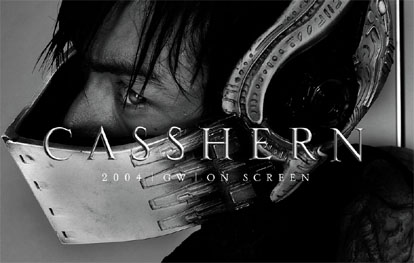
Overview: Like Immortel and Sky Captain, Casshern was one of the first movies filmed entirely on Blue or Green Screen. Casshern is by far the most ambitious of the three movies in terms of story complexity, symbols and messages conveyed, and in the scope of experimentation with visual effects. Unlike Sky Captain, this is NOT a feel-good Raiders-like fun romp. And unlike Immortel, which is also complex in scope, Casshern largely meets its intent from a story perspective. While Casshern is philosophically dense (I haven’t seen the anime yet, is it philosophically dense as well?), it does have some terrific action sequences. One of the best samurai sword duels I’ve seen happens here, as does some terrific robot vs. human fights. With its hard rock accompaniment, the action is almost matrix-like in quality.
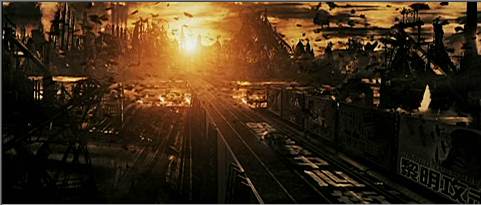
Casshern takes place in a very mechanized dystopian alternate future, in which the forces of Europa and the Greater Eastern Federation have been fighting a 50 year war for dominance. The Greater Eastern Federation has finally established control over the Eurasian continent, and now has to deal with the horrid side-effects the endless years of a chemical, biological, and nuclear war. The earth’s environment is in shambles, most of civilization has been wiped out and people usually wear protective masks when venturing outside.
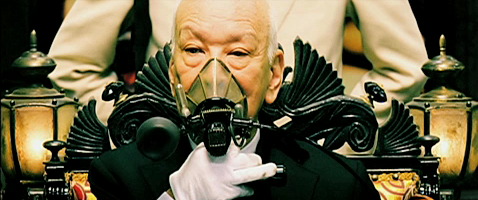
Its in this environment that Dr. Azuma, a genetic scientist, comes up with a solution to the maladies. He says he has discovered special “neo-cells” that can regenerate human tissue, and in effect, can create “replaceable parts” for the human body. An aging General with serious health problems jumps on this solution and sets Dr. Azuma up with a lab funded by the military. Casshern centers around the life of Dr. Azuma’s son Tetsuya, who in rebelling, decides to join the army. Unfortunately, he finds out that war is truly hell, and eventually ends up dying. His ghost comes back to say goodbye to his mother and fiancee, but things don’t go as planned. Unfortunately, Dr. Azuma’s research is not going very well. To extract more “Neo-cells,” the military ends up engaging in ethnic cleansing of the oldest part of Eurasia - sector 7. They bring back the body parts for the good doctor to use in extracting the Neo-cells.
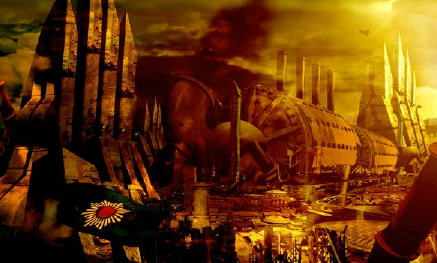
We find, however, that Sector 7 is inhabited by an ethnic group who were devout followers of a Gaurdian Spirit called Casshern. Casshern decides to make his presence felt and sends his lightning bolt down from the heavens, right into Dr. Azuma’s lab, and gives the Neo-cell “pool” the ability to bring the dead body parts back to life. After massive amounts of zombie-like people (later referred to as neo-sapiens) emerge from the pool (sparking the military to go all out in killing them), Dr. Azuma gets the idea that if he places his son Tetsuya in the pool, he will come back to life as well. This works, and Tetsuya gets reborn, but as a faster, stronger version of himself, just like the newly formed “neo-sapiens.”
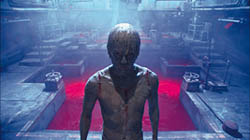
After the military hunts down and kills virtually all of the neo-sapiens, the few remaining Neo-sapiens escape to Sector 7, and after a cry for help, their prayers are answered when the Gaurdian Casshern sends them down an ancient stronghold, completely with robot warrior making capabilities. The rest of the movie involves the ongoing conflict between the Neo-sapiens and the Greater Eastern Federation, and the role that Tetsuya (who later takes the name Casshern when defending the local people) and his family plays in it. There is also a really nice love story that takes place between Tutsuya and Luna. They apparently have been fated for one another since birth, and will continue to be together throughout time.

The Visuals: Casshern has some of the most astounding visuals on film. More impressive is the use of various color palettes and textures to represent various themes in the movie. Death is represented by streaking white aura around a person; war is represented in a black and white pixilated look; Impending doom is represented in yellow; green represents life; the Neo-sapiens have the dark blue and bright red colors, etc. Truly, the diversity in visual effects is the strong highpoint of the movie. Also, I found the choice of music accompaniment consistently terrific. The choices really add to the mood. Combined with the astounding visuals, we really get a tour-de-force type “blow you away” affect. . Casshern is also heavily laden with symbols and philosophical meaning. In addition to having a strong antiwar and anti-technology message, Casshern gives us interesting religious musings, and some thoughts on implications for cheating death, and a pretty powerful message for the need for co-existence with others. Most interestingly, Casshern is able to show pain and suffering on the individual “little person” level, and show how this affects the large scale picture.
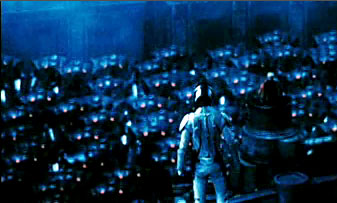
Overview: While difficult to understand (let me know if you want me to post a “page 2 spoiler” on this to explain it - it really is a very cool story), Casshern is simply an awesome picture that will develop a huge following over the years. Take the time to understand this, and you should love it. It is NOT a happy picture though, and is very emotional in tone.
~See movies similar to this one~
Tags: cyberpunk movie review
Year: 2003
Directed by: Moon-saeng Kim, Park Sunmin
Written by: Moon-saeng Kim et al.
IMDB Reference
Degree of Cyberpunk Visuals: Very High
Correlation to Cyberpunk Themes: High
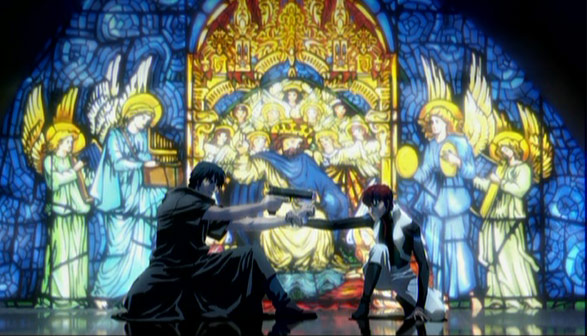
Overview: More often than not, most of the best scifi movies are coming from other countries. Anime is no exception. Wonderful Days (Called Sky Blue in some US locations) is a visual masterpiece of 2D/3D blended animation. While movies like Sinbad, with its wonderful background, but completely stuck on 2D characters shows us the low-end of this spectrum, Wonderful Days is a terrific example of the best in 2D/3D blended animation. This futuristic cyberpunk tale is not the most original, but is done more than well enough to allow to you be totally “wowed” by the visuals and incredible 3D positional sound.
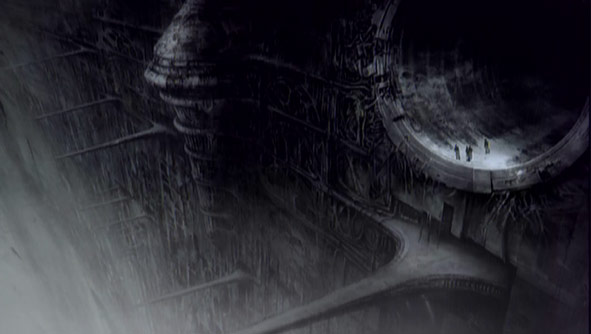
Wonderful Days takes place in a dystopic future in the year 2140. The world has been decimated and ravaged by war, reckless exploitation of the earth and over-pollution. Clouds have all but blocked out the sun and human civilization is on the brink of elimination. In this chaos, a group of elites have developed a method of using the pollution to create an energy source, and have used this to build a magnificent city called Ecoban.
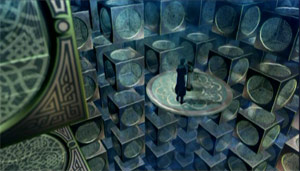 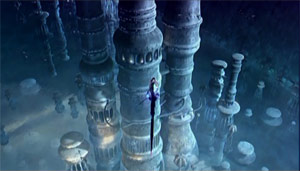
Thousands of Refugees have flocked to the Marr, the outskirt wasteland of this Ecoban in the hopes of gaining entrance, but unfortunately this has become a society of the elite and the masses. Instead, the citizens of Ecoban use the Marr as their personal slave labor to work the machines which keep Ecoban running. Life is cheap for the Marr, and the Ecoban elite care far more about their power generation than they do the welfare of the Marr. Unfortunately for the citizens of Ecoban, it appears as if the earth is starting to recover, and the level of pollution is dropping. The governing council has decided to use any means possible to maintain pollution levels to keep their hold on power.
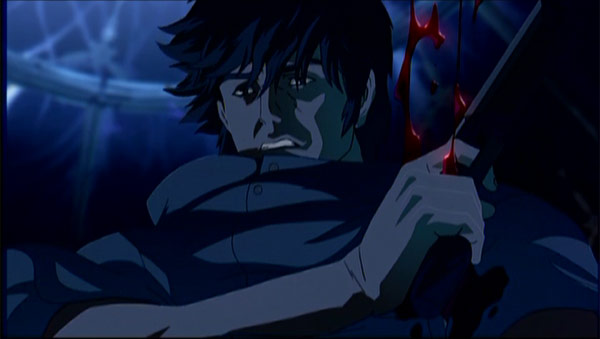
On a more personal level, this story revolves around three people, who knew each other as children living in Ecoban, but are now adults.
- Jay - a cute female captain of the Ecoban guard, who has begun to
doubt the system she supports.
- Shua - who was cast out of Ecoban as a child under dubious circumstances, only wants to show his adopted kid brother of the streets, Woody, what a blue sky looks like. He saw this once as a child with Jay, and has spent his life trying to overthrow Ecoban in order to see it again.
- Cade - the security commander of Ecoban, who is deeply in love
with Jay.
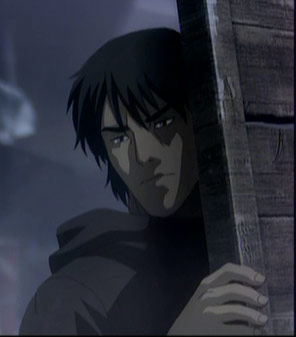 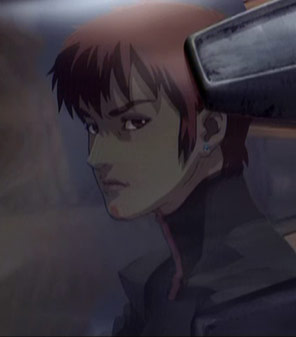
Shua, with the help of a aging Ecoban Engineer-turned resistance leader named Dr. Noah, who was involved in the creation of Ecoban’s power source, has infiltrated Ecoban’s key computer, the Delos System. There he hopes to get information to learn how to destabilize and destroy Ecoban. Unfortunately, he sets off alarms, and is forced to escape, and ends up facing off against his former best friend Jay. After he escapes, Jay seeks him out in the Marr, and they eventually re-establish their friendship, and eventually their love for one another. Meanwhile, Cade, with the help of the Malevolent Commander Locke will stop at nothing to protect the city he loves. When he finds out that his former rival Shua is involved, and that he is re-established contact with Jay, he only has one course to pursue - the total destruction of Shua and the resistance.
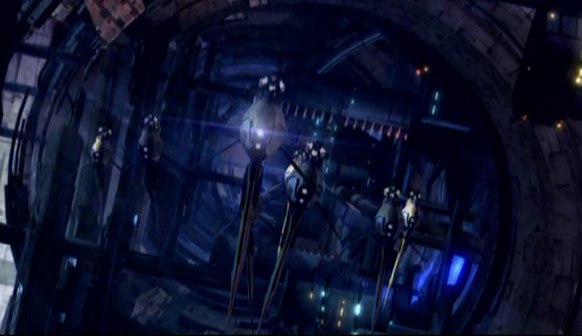
The Cinematography:While the story is by no means original, the cinematography is simply stunning on every level. Wonderful Days uses real film-like effects to increase the “realness,” believability and engagement far more than any animation I’ve seen. We get everything from the use of out of focus backgrounds, changing focal points, lens flares, jerky camera movements, and incredibly interesting perspective shots. On top of this, we get wonderfully rendered raindrops, rendered under-water explosions intermixed with hand drawn fire, and the most incredible array of deep and vibrant color effects in virtually every scene.
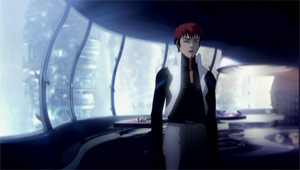 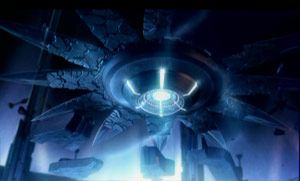
And while all this is astounding, what truly blows you away is the quality of the intermixing of 2D and 3D animation. Its almost hard to explain how well the 2D animation is blended, especially if you’ve seen something like Sinbad, which almost just layers the 2D on top of a background like velcro puppets on a background. Here we get blended effects that truly serve to tie the 2D with the 3D animation. Wonderful Days is simply the best out there at this type of animation.
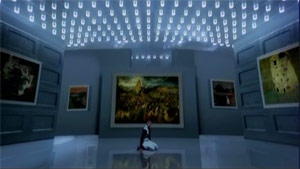 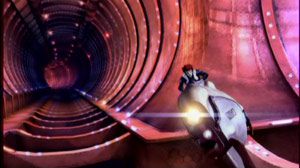
Sound Effects: While the cinematography is the real crown of this movie, the sound effects aren’t far behind. Truly, this is the best use of positional surround sound I’ve heard in an anime. We have wonderful “swoop” sounds by the motorcycles that are as good as live action racing movies, realistic explosions complete with pieces flying at you, detailed gunfire and wind sounds, and more importantly, a clear level of care throughout that rarely is equaled. As an interesting effect, the selections in the score are almost disconcerting in how different they are. We have everything from rock music to a wonderful use of opera at the end for emotional building.
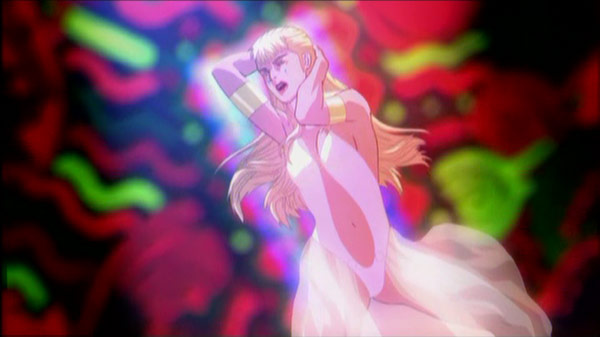
Is this Cyberpunk? You bet it is. While we don’t have the traditional merging of man and technology, all the other elements are here in spades. We get a glorious depiction of a the seedy underground, the powerful elite, impressive hacking, a wonderfully rendered dystopia, flawed heroes, and most importantly - style in abundant quantities!
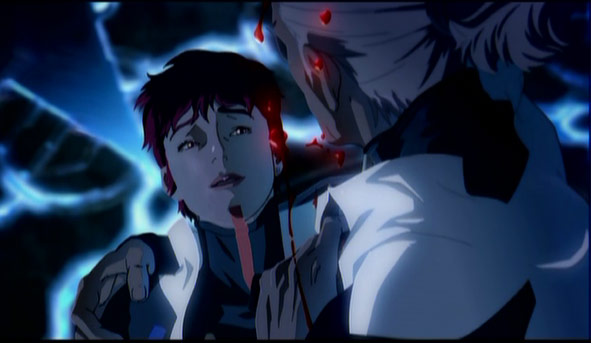 ] ]
The Bottom Line: If you’re interested in seeing the best in immersive scifi anime, Wonderful Days is a fine choice. While it doesn’t have close to the philosophical depth of Oshii’s movies, the story moves along and the immersive action is simply breathtaking. You truly do think you’re watching a continual piece of art go across the screen. And again, while the story is neither complex nor innovative, it is decently well done, especially if you dig cyberpunk-type themes. However, the quality of the cinematography and the intense care given to this film easily raises Wonderful Days up one of my favorite all-time cyberpunk movies.
Get this for the visuals and overall cyberpunk style. Wonderful Days truly deserves to be seen by all.
~See movies similar to this one~
Year: 1995
Directed by: Robert Longo
Written by: William Gibson (short story, screenplay)
IMDB Reference
Degree of Cyberpunk Visuals: High
Correlation to Cyberpunk Themes: Very High
Key Cast Members:
Johnny Mnemonic: Keanu Reeves
Jane: Dina Meyer
J-Bone: Ice-T
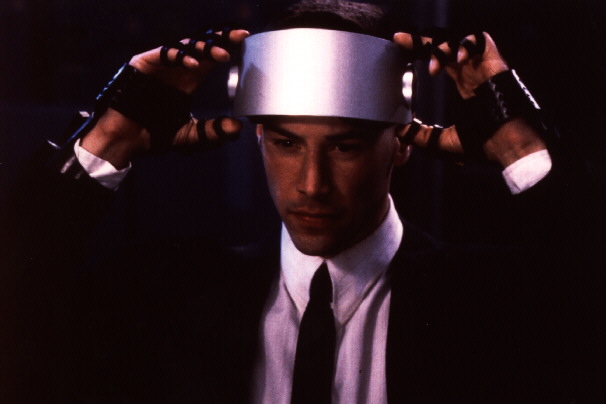
Listen. You listen to me. You see that city over there? THAT’S where I’m supposed to be. Not down here with the dogs, and the garbage, and the fucking last month’s newspapers blowing *back* and *forth*. I’ve had it with them, I’ve had it with you, I’ve had it with ALL THIS —
I WANT ROOM SERVICE!!! I want the club sandwich, I want the cold Mexican beer,
I want a $10,000-a-night hooker. I want my shirts laundered…like they do…
at the Imperial Hotel…in Tokyo.
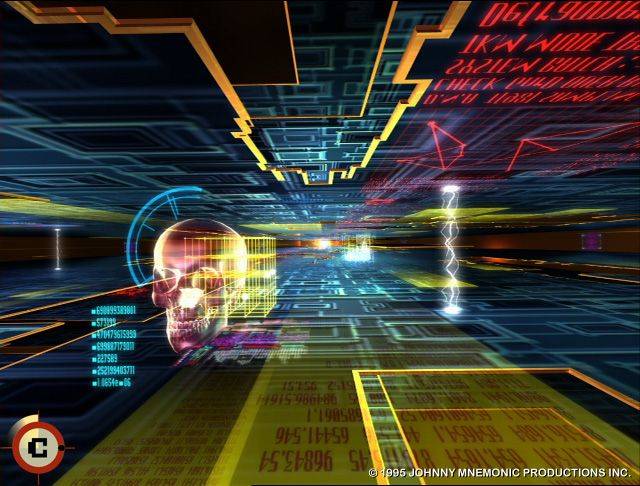
Overview: Johnny Mnemonic has always been a guilty pleasure of mine. Yes, this movie has problems, not the least of which is having a name that I can never remember how to spell, but overall, this movie is just pure cyberpunk fun! Johnny Mnemonic has a terrific mix of “punk” and “cyber” although it definitely strays to the “punk” side of things. He we have corporate domination, punk rebellion, modified humans (and dolphins!), dystopian societies and all the rest, all wrapped up in some wonderfully inspired William Gibson visuals.
Johnny (played by cyberpunk zen master, Keanu Reeves) is a data courier who deals in somewhat shady and dangerous clients in need of data getting discretely transferred to another location. He has gotten a large chunk of his long term memory removed in order to have enough space to put a massive hard drive inside his head. Unfortuantely, his space isn’t large enough for his newest high paying customer, but he still takes the assignment even though there’s danger of data seepege into the brain. During the “transfer,” all hell breaks loose, with guns and bullets flying everywhere. Johnny is forced to flee, and eventually hooks up with a damaged bodygaurd played by Dina Meyer. Together they attempt to deliver the data from China to New Jersey, but unfortunately, SERIOUS complications arise when they find out what Johnny is actually holding in his head. Ice Tea and Takeshi Kitano also have notable roles in this flick.
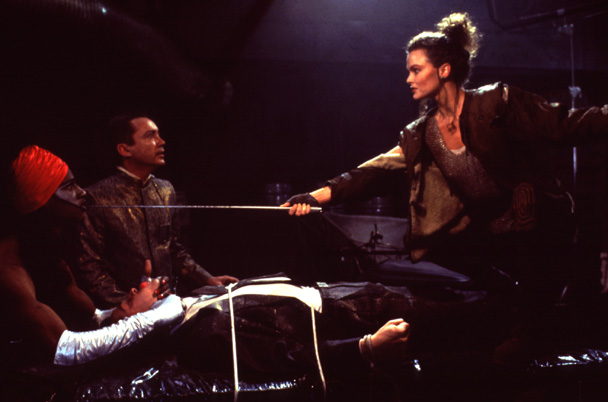
The Bottom Line: Johnny M., while mostly a scifi thriller, has some terrific lines. For anyone who’s seen this, you will remember the “I want room service” scene. I still love that! While I can’t argue that this is a great movie, I do really enjoy it. Still, it clearly could have been better. But at least this is contrasted with a few really fun scenes.
~See movies similar to this one~
Tags: cyberpunk movie review
Year: 2003
Directed by: Hiroshi Hamazaki
Written by: Chiaki Konaka
IMDB Reference
Degree of Cyberpunk Visuals: Very High
Correlation to Cyberpunk Themes: Very High
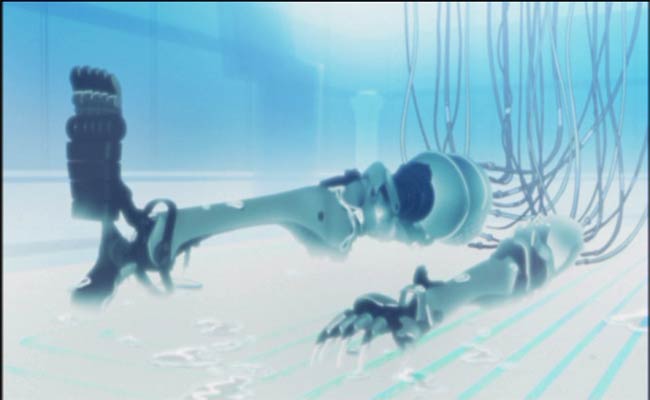
Overview: Written by one of the most prolific anime writers, Chiaki Konaka (Who also wrote Lain, Malice@Doll, Hellsing, Bubblegum Crises, etc.), Technolyze is a virtual feast of visuals wrapped up in a Lain-style fragmented cyberpunk gangster story. Like Lain, the beginning is almost non-sensical, but creates the foundation for the mood of the rest of the story.
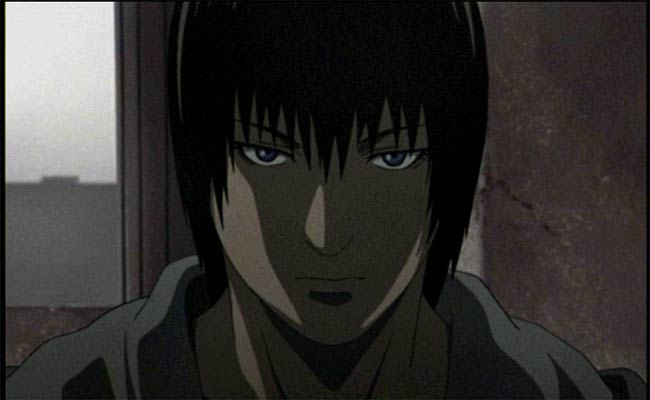
Texhnolyze is the name for the technology to make fully integrated cybernetic limbs like those above. The story follows Ichise, a former down-and-out boxer living in Luckass, a truly disturbed city with the elite rich side and the poor slums. Ichise inadvertently crosses the local mafia (called the Organo), and ends up getting an arm and leg chopped off. But luck would have it that he’s a perfect candidate for a hot chick Texhnolyze’s doctor’s experiments in the latest Texhnolyze research. Ichise carries around a capsule containing his dead mother’s body cells, which the doctor integrates into the limbs. Ichise spends many episodes figuring out how to get revenge for how he changed, but based on discussions with a girl who can see the future, his motivations change as the series moves forward.
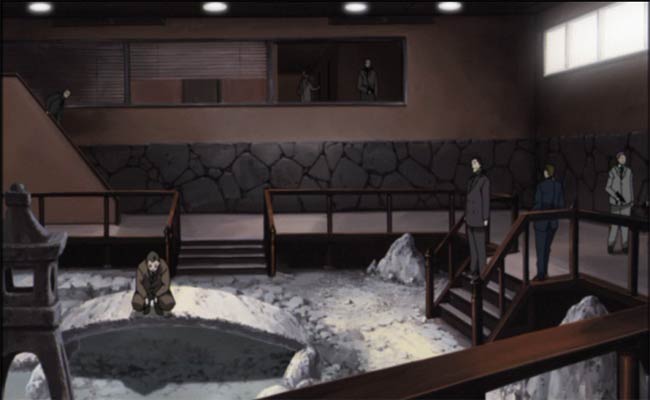
This is NOT a kids story. Every episode has LOTS of gangster-like killings. We get lots of guns and a few cool sword fights. We also get some nice Texhnolyze deaths with fists going through faces. Truly, this might be described as Goodfellas meets Serial Experiments Lain. And while I haven’t gotten the last DVD set, I’m guessing this is is NOT going to be an uplifting story.
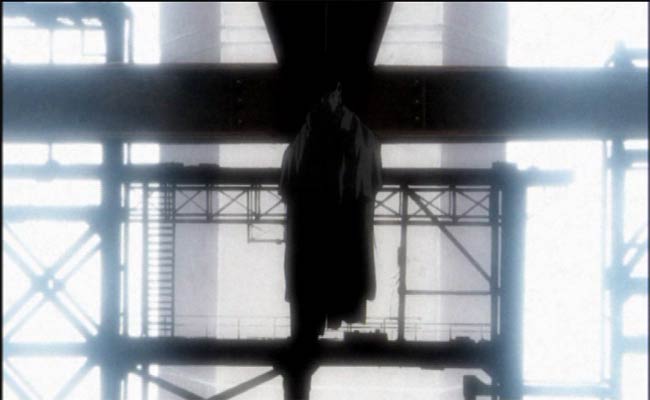
The Visuals: Unlike Lain, Texhnolyze is as Neo-noir as they come. The use of shadows is amazing. We get lots of stark white on blacks, interesting gray patterns, and lots of yellows and browns. Also, virtually every character is flawed and mysterious. While the anime is truly riveting, you won’t find yourself becoming attached to anyone. The characters simply aren’t sympathetic.

Texhnolyze is a virtual feast of visual textures and palettes. Whenever you look through a texhnolyzed person’s eyes in first person, you see almost a terminator-like display, only the screen is filled with noise. We also get the most incredibly detailed background sets. Truly, you feel like you know this city after watching a few DVDs worth of this. We also get great camera angles, with sweeping shots, extreme close-ups intermixed with psychedelic-like image merges. Top this with a terrific score and wonderful surround sound, and the WOW effect hits you in total.
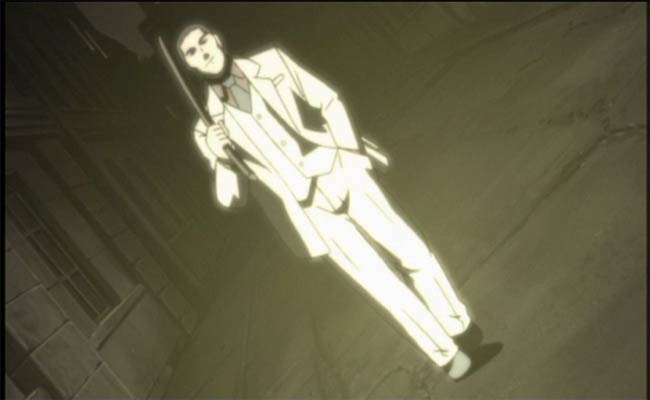
The Bottom Line: Truly, its clear that the creators of Texhnolyze wanted to make something as overtly cyberpunk as possible. They truly have succeeded. Texhnolyze is not for everyone, as the story is violent, obscure, and cold. It is however, a truly awesome and totally original cyberpunk series!
~See movies similar to this one~
Tags: cyberpunk movie review anime Texhnolyze
|










































































 ]
]











